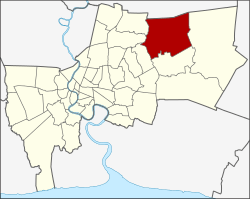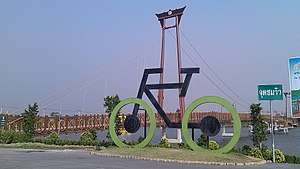Khlong Sam Wa District
| Khlong Sam Wa คลองสามวา | |
|---|---|
| Khet | |
 Dolphin show at Safari World | |
 Khet location in Bangkok | |
| Coordinates: 13°51′35″N 100°42′15″E / 13.85972°N 100.70417°ECoordinates: 13°51′35″N 100°42′15″E / 13.85972°N 100.70417°E | |
| Country | Thailand |
| Province | Bangkok |
| Seat | Bang Chan |
| Khwaeng | 5 |
| Khet established | 21 November 1997 |
| Area | |
| • Total | 110.686 km2 (42.736 sq mi) |
| Population (2017) | |
| • Total | 193,930[1] |
| • Density | 1,752.07/km2 (4,537.8/sq mi) |
| Time zone | UTC+7 (ICT) |
| Postal code | 10510 |
| Geocode | 1046 |
Khlong Sam Wa (Thai: คลองสามวา, pronounced [kʰlɔ̄ːŋ.sǎːm.wāː]) is one of the 50 districts (khet) of Bangkok, Thailand. It is bounded by other districts (from north clockwise): Amphoe Lam Luk Ka of Pathum Thani Province, Nong Chok, Min Buri, Khan Na Yao, Bang Khen, and Sai Mai of Bangkok.
History
Khlong Sam Wa was established as a district on 21 November 1997 by splitting from Min Buri. Khlong Sam Wa was the name of an amphoe in Min Buri and hence the name is used as the district name. In 1947 when the area was still rural, the farming community of Bang Chan was chosen as a centre for Thai studies.[2]
Administration
The district is divided into five sub-districts (khwaeng).
| 1. | Sam Wa Tawan Tok | สามวาตะวันตก | |
| 2. | Sam Wa Tawan Ok | สามวาตะวันออก | |
| 3. | Bang Chan | บางชัน | |
| 4. | Sai Kong Din | ทรายกองดิน | |
| 5. | Sai Kong Din Tai | ทรายกองดินใต้ |
District council
The district council for Khlong Sam Wa has seven members, who each serve four-year terms. Elections were last held on 30 April 2006. The Thai Rak Thai Party won seven seats.
Places

- Safari World
- Wari Phirom Park
School
External links
References
- ↑ "Population and House Report for Year 2017 (see page 2 for data of this district)". Department of Provincial Administration, Ministry of Internal Affairs. Retrieved 2018-04-01. (Search page)
- ↑ Sharp, Lauriston; Hanks, Lucien M. (Winter 1983). Brian L. Foster. ed., ed. "Bang Chan: Social History of a Rural Community in Thailand". Ethnohistory. Duke University Press. 30 (1): 35–36. doi:10.2307/481501. JSTOR 481501.
.svg.png)